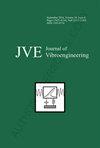Research on automatic detection of gradual fault of high voltage electric energy metering transformer based on fuzzy rough set and whale optimization algorithm
IF 0.7
Q4 ENGINEERING, MECHANICAL
引用次数: 0
Abstract
Based on fuzzy rough set and whale optimization algorithm, the automatic fault detection method of high-voltage electric energy metering transformer is studied to improve the fault diagnosis effect and efficiency. On the basis of constructing the mathematical model of gradual fault of high-voltage electric energy metering transformer, the fuzzy rough set theory is used to reduce the data attributes of fault samples, eliminate similar attributes, determine the minimum fault feature set, and complete the fault feature selection, which is used as the input of the fault detection model based on Whale Optimization Algorithm-based Support Vector Machine (WOA-SVM). After the kernel parameters and penalty factors of SVM are optimized by whale optimization algorithm, the type of gradual fault of high-voltage electric energy metering transformer is identified. The experimental results show that the reduced fault attributes are distributed differently in the sample data, and the fault detection accuracy can be improved by 9.5 % through fault feature selection. The fault diagnosis model with Gaussian radial basis function, kernel parameter of 0.05 and penalty factor of 10 has the best performance. This method can identify the gradual fault types of high-voltage electric energy metering transformers, and the fault diagnosis effect is outstanding.基于模糊粗糙集和鲸鱼优化算法的高压电能计量互感器渐变故障自动检测研究
基于模糊粗糙集和鲸鱼优化算法,研究高压电能计量互感器故障自动检测方法,提高故障诊断效果和效率。在构建高压电能计量互感器渐变故障数学模型的基础上,利用模糊粗糙集理论对故障样本的数据属性进行还原,剔除相似属性,确定最小故障特征集,完成故障特征选择,作为基于鲸鱼优化算法的支持向量机(WOA-SVM)故障检测模型的输入。通过鲸鱼优化算法对 SVM 的核参数和惩罚因子进行优化后,识别出高压电能计量互感器渐变故障的类型。实验结果表明,减少的故障属性在样本数据中的分布不同,通过故障特征选择,故障检测精度可提高 9.5%。采用高斯径向基函数、核参数为 0.05、惩罚因子为 10 的故障诊断模型性能最佳。该方法可识别高压电能计量互感器的渐变故障类型,故障诊断效果显著。
本文章由计算机程序翻译,如有差异,请以英文原文为准。
求助全文
约1分钟内获得全文
求助全文
来源期刊

Journal of Vibroengineering
工程技术-工程:机械
CiteScore
1.70
自引率
0.00%
发文量
97
审稿时长
4.5 months
期刊介绍:
Journal of VIBROENGINEERING (JVE) ISSN 1392-8716 is a prestigious peer reviewed International Journal specializing in theoretical and practical aspects of Vibration Engineering. It is indexed in ESCI and other major databases. Published every 1.5 months (8 times yearly), the journal attracts attention from the International Engineering Community.
 求助内容:
求助内容: 应助结果提醒方式:
应助结果提醒方式:


